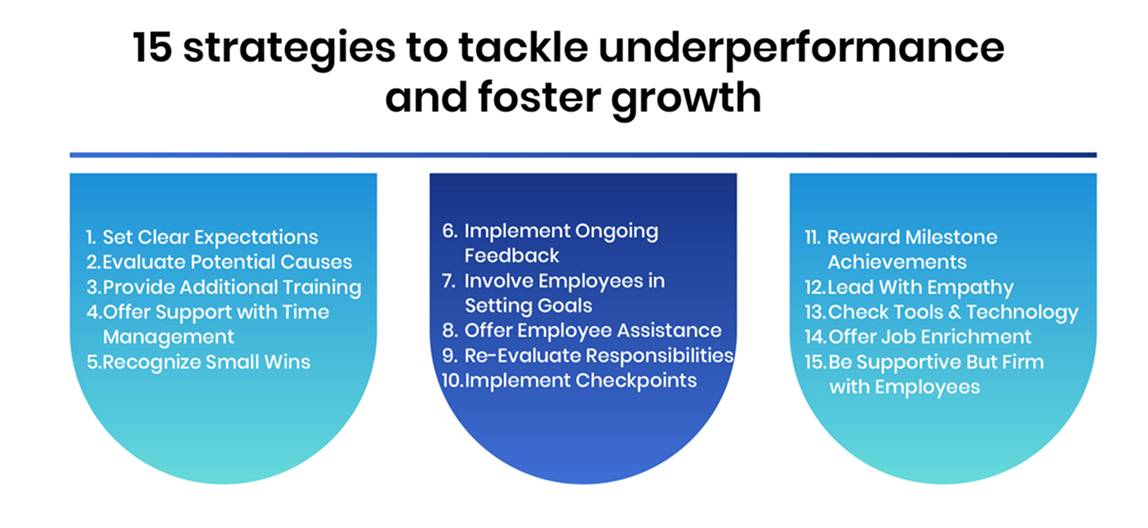
Employee engagement and productivity are vital for organizational success. However, sometimes employees lose motivation and underperform. As a manager, it’s crucial to identify disengaged employees early and take necessary steps to re-engage them. This will not only enhance individual productivity but also lift team morale.
Below are 15 effective strategies to help managers address underperformance and promote long-term growth.

Setting clear expectations is the critical first step when addressing an underperforming employee. As a manager, you should schedule a team meeting focused specifically on communicating responsibilities, objectives, policies, deadlines, and your precise standards for quality of work. Be as direct, detailed, and specific as possible so there is no room for ambiguity or misinterpretation. Provide plenty of examples to illustrate your expectations.
Send a comprehensive follow-up email after the meeting that recaps all the key points covered. This written documentation ensures absolute clarity on expectations for all employees. Revisit these expectations in 1-on-1s and team meetings to reinforce. If an underperforming employee claims they were unsure of expectations, you can refer back to this documentation. Clear communication of expectations, both verbally and written, is the foundation for productivity.
When addressing an underperforming employee, an open and empathetic 1-on-1 conversation focused on root causes is imperative. There may be underlying reasons, whether work-related or personal, driving the productivity issues. Ask the employee if there are any particular processes, tools, or deadlines they are struggling with. Inquire if they feel fully equipped with the skills and training needed for tasks or if certain areas are difficult for them currently.
Discuss if there are external factors in their life that could be affecting focus or energy levels at work. Listen without judgement and seek to deeply understand their perspective. Evaluation of potential causes, both internal workplace and personal external, enables you to determine the true sources impacting their performance. This better positions you to offer relevant support and solutions tailored to their situation. Maintaining an open dialogue instead of an accusatory tone is key to a constructive discussion.
Once potential skills gap or development areas related to underperformance are identified, providing supplemental employee training is an impactful solution. While initial job training may have been sufficient, refreshed training around struggling areas reminds employees of core competencies needed for their role.
Training presents an opportunity to sharpen existing skills, build confidence in newer skills, and address recurring knowledge gaps. The key is ensuring the training directly aligns with the underperforming employee's needs, providing extra time and resources for upskilling. The supplemental hands-on training offers a risk-free environment for the employee to ask questions and improve.
Couple training with check-ins after implementation to see if the employee is exhibiting growth or if additional mentoring is needed in that skill area. Investing in relevant training tailored to the employee’s needs showcases your commitment to their success.
For some underperforming employees, the root cause of productivity challenges ties back to insufficient time management skills and discipline. Difficulty prioritizing tasks, overlooking deadlines, and poor organizational habits can prevent employees from reaching maximum efficiency and output. Host a working session with the employee to collaborate on time management techniques that suit their work style. Introduce organizational tools like calendar blocking, daily task lists, use of alarms, or productivity methodologies that resonate with them.
Adjust deadlines to be more reasonable and achieve balance. Implement weekly check-ins to receive progress updates and offer coaching through recurring pain points. Displaying sincere commitment to helping employees overcome time management challenges through ongoing support fosters trust and accountability on both sides. As the employee exhibits improvement, gradually reduce extra oversight. The goal is to equip them with tangible tools and skills for disciplined time management that facilitate reliable strong performance.
When an underperforming employee demonstrates initiative towards improvement, even via small wins, immediate recognition is warranted. This timely positive reinforcement shows you notice and value their effort. After having candid conversations about needing to increase productivity, it can be motivating for employees to receive acknowledgment of early wins.
Verbally praising their contribution during 1-on-1s or giving public employee recognition among the wider team can positively shape behaviors moving forward. Spotlight moments worth celebrating so the employee connects their effort to feeling engaged and fulfilled at work. The emotional impact of linking wins, both small and large, back to positive recognition builds confidence, productivity momentum, and employee loyalty over time.
Providing regular feedback is vital for improving employee performance. Schedule weekly one-on-one meetings with the underperforming employee to offer constructive feedback on their work. Be specific about what they are doing well and where there is room for improvement. Provide clear, actionable guidance on steps they can take to enhance their productivity and meet expectations.
For example, if meeting deadlines is an issue, set an interim milestone deadline for their next project. Have them submit a progress report and offer suggestions on better time management strategies. Maintain an open, non-judgmental tone focused on collaborating - not criticizing. Ongoing feedback conversations reinforce expectations while supporting professional growth.
Collaboratively setting S.M.A.R.T performance goals promotes employee ownership over improvement plans. Schedule a working session allowing the underperforming employee to actively contribute in establishing goals. Ensure alignment with company objectives while incorporating their input to boost engagement.
For example, if the quality of work is lacking, have them suggest ideas for decreasing errors. Then mutually agree on measurable targets for accuracy and completeness. Check-in regularly on goal progress, modifying timeframes or realigning tasks if needed. Involving employees in setting their own productivity goals and standards builds accountability while providing motivation.
Sometimes personal challenges unrelated to work can significantly impact job performance. If an employee shares personal struggles, inform them about Employee Assistance Programs (EAP) offering counseling services and other resources. Maintain confidentiality while encouraging them to access EAP to address any mental health, financial or family issues.
Promote a supportive environment where employees feel comfortable asking for help when facing crises. Offer reasonable accommodation like temporary telecommuting or adjusting start times. By connecting employees to EAP assistance and providing compassionate flexibility, managers enable stabilization of personal emergencies to improve on-the-job productivity.
Take time to critically analyze if the employee’s skill sets properly match assigned tasks. Underperformance may indicate a workflow misalignment versus poor work ethic. Consider shifting responsibilities better suited to individual strengths. Alternatively, excess workload could overwhelm anyone. Assess priorities and explore delegating particular tasks to other team members.
Schedule a meeting allowing the employee to share which responsibilities feel most challenging or draining. Actively listen, resisting any temptation to be defensive about initial role assignments. Then collaboratively discuss potential workflow and duty adjustments tailored to their abilities. By re-evaluating job alignment, you optimize productivity and boost employee satisfaction.
Frequent check-ins provide vital touchpoints to connect with underperforming staff. Schedule brief yet consistent meetings such as daily standups, weekly reviews or mid-month progress checks. Use these interactions to monitor productivity numbers, address obstacles, offer motivation and remind about goals.
For example, a daily standup allows the employee to share productivity blocks from the prior workday. Then offer guidance on overcoming those barriers to hit targets for the next day. Checking in more frequently establishes a feedback cadence to keep performance on track. It also conveys your investment in their growth through consistent availability - a strong motivator. By implementing consistent checkpoints, managers gain valuable insights while demonstrating strong support.
As employees reach major goals outlined in their performance improvement plan, managers should provide small rewards to positively reinforce continued progress. Some examples of potential rewards include:
The timing and choice of rewards should align with accomplishments meaningful to that individual employee. Keeping rewards small yet meaningful helps reinforce positive momentum without overshadowing the intrinsic motivation fueling sustainable growth.
Creating an environment where employees feel comfortable sharing work-related or personal challenges impacting their productivity requires leading with empathy. Some ways managers can demonstrate empathy include:
Active Listening:
Caring Mindset:
Trust and Acceptance:
By leading with empathy, managers foster engaged, loyal teams who know their leaders truly care.
Before assuming lagging productivity stems from the employee, assess if inadequate tools or systems are actually causing barriers. Some key things to evaluate:
After identifying the root technological and tool-related issues, map out solutions such as:
Enhancing tools and systems lifts productivity levels across entire teams when adopted at scale.
When underperformance stems from lack of engagement or stalled career growth, job enrichment provides internal mobility to reignite passion. Examples include:
By offering enriching opportunities that match individual interests, managers boost fulfillment, skills, and visibility fueling retention and performance.
When addressing underperformance, managers must convey:
This balance demonstrates care for employees' success while upholding accountability. Be transparent from the start that continued productivity issues have consequences, potentially including:
The goal is to motivate employees to improve - not punish them. By being supportive yet firm, managers give clear direction while inspiring optimal engagement and performance.
The key is addressing productivity problems immediately, collaborating on solutions, providing support, giving rewards based on achievements, and pairing empathy with accountability. With this constructive approach, you can get struggling employees back on track to reach their full potential.